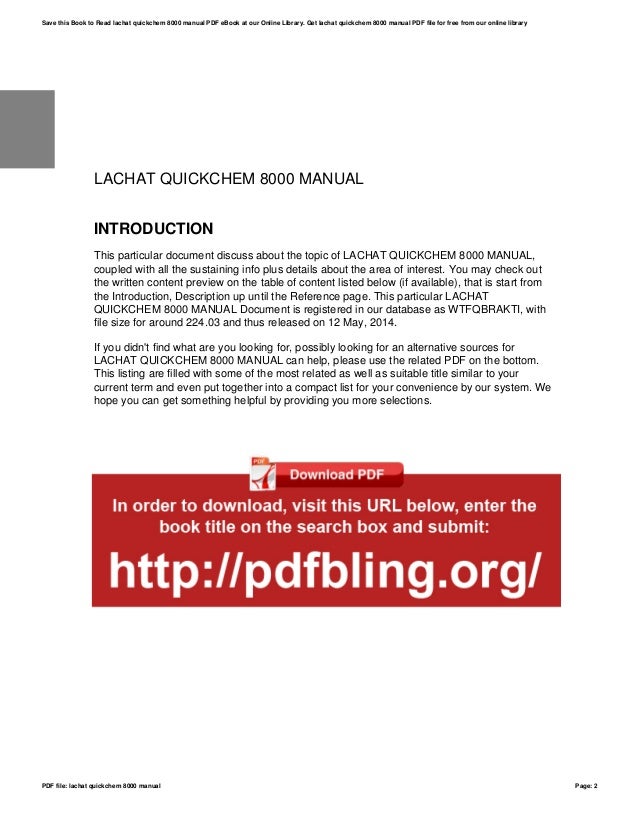Lachat Quickchem 8000 Manual
The Lachat QuikChem® 8500 Series 2 is the leader in automated ion analysis. Utilizing proven Flow Injection Analysis(FIA) technology, the QuikChem increases efficiency and reduces cost for labs requiring high sample throughput. Lachat’s QuikChem® 8500 Series 2 Flow Injection Analysis System features high sample throughput and simple but rapid method changeover. The QuikChem Flow Injection Analysis system maximizes productivity in determining ionic species in a variety of sample types, from sub-ppb to percent concentrations. With over 500 methods for environmental, agronomic and industrial applications, including USEPA accepted and equivalent methods, the QuikChem 8500 will satisfy analytical requirements. QuikChem 8500 Series 2 Attributes Depth 24.03 in Height 9.9 in Width 27.6 in Additional Specifications Analysis Methods: FIA (Flow Injection Analysis); Integrated IC (Ion Chromatography) Channels: Max.
5 Light Source: Tungsten Halogen Lamp Detector: Dual beam photometer (340-880 nm) A/D Converter: 24 bit Heating Unit: 25-160 ¨C Valve: High-performance 6 port injection sample valve Filter Type: Interference Filter Reagent Pump: 12 and 16 positions controlled by software Dilutor: Dilution Factor 1.6, 4000 steps Accuracy and Reproducibility: 0.5% Mixing Coil: Teflon Tubing Flow Cell: 10 mm or 20 mm path length Dimensions: 2 channel unit= 27.60 x 16.01 x 9.90 in. Peak Measurement: Area/Height Tube I.D.: 0.8 mm/0.5 mm Injected Sample Volume: 2 µL - 250 µL Sample Throughput: 90 tests/hour/channel Data Quality Control: Real time closed-loop control of data quality Hardware: PC included with system Software: 32-bit Omnion 3.0; Data Quality Management enabled; LIMS import/export capabilities; Multi-language supported.
Nitrate + Nitrite (NO 3- + NO 2-): Lachat QuikChem 8500 Flow Injection Analyzer I) Principle Nitrate is reduced quantitatively to nitrite by passage of the sample through a cadmium metal. The nitrite (reduced nitrate plus original nitrite) is then determined by diazotizing with sulfanilamide followed by coupling with N-(1-naphthyl ) ethylenediamine dihydrochloride. The resulting water soluble azo dye has a magenta color which is detected at 520 nm. II) Preparation of Stock Standard A) In a 1000-mL volumetric flask, dissolve 7.218 g potassium nitrate (KNO 3) to the mark with deionized water.
This stock standard solution is 1000.0 mg N/L as NO 3. Discard after one year. B) In a 1000-mL volumetric flask, dissolve 6.076 g potassium nitrite (KNO 2) to the mark with deionized water. This stock standard solution is 1000.0 mg N/L as NO 2. Discard after one year.
III) Preparation of Reagents NOTE: To prevent bubble formation, degas all reagents vigorously with helium for one minute/L of reagent set approximately at 20 lb/in 2. A) 15 M Sodium Hydroxide Add 540 g sodium hydroxide ( NaOH) to 900 mL of deionized water. Stir to dissolve. Cool and store in a plastic bottle. CAUTION: This solution will get very hot. B) Stock Ammonium Chloride/EDTA Buffer, pH 8.5 To a tared 1-L container, add 778.5 g deionized water. In the hood, add 113.4 mL concentrated hydrochloric acid ( HCl) and 85.5 mL ammonium hydroxide (NH 4OH).
Add 0.9 g disodium ethylenediame tetraacetate (Na 2EDTA). Invert until dissolved. Adjust the pH to 8.5 with 15 M NaOH. C) Sulfanilamide Color Reagent To a tared, dark 1 L container, add 788.4 g deionized water, 90 mL of 85% phosphoric acid (H 3PO 4), 36.0 g sulfanilamide and 0.9 g N-(1-naphthyl ) ethylenediamine dihydrochloride (NED). Stir until dissolved. Store in an amber bottle.
Stable one month. D) Sodium Hydroxide-EDTA Rinse To a tared 1-L container, add 900 mL deionized water, 58.5 g sodium hydroxide ( NaOH) and 5.4 g tetrasodium ethylenediamine tetraacetic acid (Na 4EDTA). Stir until dissolved. E) Carrier Deionized water. IV) Sample Handling A) Run filtered sample as soon as possible or freeze until analysis. B) The functional pH range of the ammonium chloride buffer is 5-9. Adjust the pH of samples outside this range using either concentrated hydrochloric acid ( HCl) or ammonium hydroxide (NH 4OH).
V) Analysis Procedure A) Install 520-nm interference filter and the appropriate sample loop. B) Place all reagent and carrier lines in Sodium Hydroxide-EDTA rinse and pump for 5 minutes. C) Place all reagent and carrier lines in deionized water and pump for 5 minutes. D) Place all reagent and carrier lines in the appropriate reagents. Pump for 5 minutes.


E) Turn off pump and connect the cadmium column to the reaction module so that the sample-carrier-buffer mixture flows through a mixing coil, through the column and then into a tee fitting to join the sulfanilamide reagent. Note: Do not allow air to run through the cadmium column. F) Calibrate with standards that bracket the sample concentration. Correlation coefficient should be greater than or equal to 0.990. Check the calibration curve for drift, accuracy and precision with standards and controls every 20 samples. G) Determine that the cadmium column reduction efficiency is within 90%.
Lachat Quikchem 8000 Manual
1) Run a high level nitrite calibrant followed by the same concentration nitrate calibrant. 2) Calculate percent reduction efficiency (Nitrate peak area/nitrite peak area) x 100. 3) If the cadmium surface is insufficiently active (.